
4.9★ on G2 reviews

4.7★ on Capterra reviews
Explore fresh, expert perspectives on customer engagement and innovation
Stay at the forefront of customer engagement, contact centre innovation, and AI-powered communication.
discover the latest
articles and insights
.png)
Three Bold Predictions for the Future of Customer Interactions in Contact Centres
At MaxContact’s ‘Afterwork’ community event, Jonty Pearce, the Founder of Call Centre Helper, shared his top three predictions for the future of the contact centre industry. While making predictions can be a bit daunting, especially in such a rapidly evolving field, Pearce believes that by examining past trends and current data, valuable insights can be gained into what lies ahead. However, he emphasises the importance of taking these predictions with a pinch of salt, as the future is always uncertain.
Prediction 1 – Voice Will Remain the Primary Channel
Despite the growing popularity of digital channels, data shows that voice interactions have actually increased slightly over the past decade, currently accounting for 55% of inbound contact centre traffic.
While younger generations may prefer messaging and chat, the majority of customers still value the personal touch of a phone conversation. Pearce cautions contact centres not to neglect voice channels in favour of digital alternatives, as this can lead to frustration and dissatisfaction among customers who prefer traditional methods of communication.
Prediction 2: AI Will Have a Profound, Long-term Impact
Artificial intelligence (AI) is already beginning to revolutionise the contact centre industry, but its impact will be felt gradually over time. In the short term, Pearce suggests that AI can be effectively leveraged for tasks such as speech analytics, after-call notes, and generating knowledge base articles.
However, he cautions against relying too heavily on AI-powered chatbots for customer interactions, as they are currently flagged by 36% of people as the channel most likely to deliver a poor outcome. As AI technology matures and becomes more accurate, its potential applications will expand, but this process will take time.
Watch the full talk from Jonty Pearce, Founder of Call Centre Helper:
Prediction 3: Customer Service Will Become the New Marketing
In the coming years, Pearce predicts that companies will begin to view customer service as a crucial investment rather than a mere cost centre. As customers grow increasingly frustrated with offshoring, chatbots, and the lack of voice support, businesses that prioritise exceptional customer service will gain a significant competitive advantage.
It’s well-established that retaining existing customers is more cost-effective than acquiring new ones, and even a 5% increase in customer retention can lead to a 25% increase in profits. By focusing on customer lifetime value (LTV) and the long-term benefits of customer loyalty, contact centre leaders can make a compelling case for investing in superior service.
In conclusion, while the future of customer interactions in contact centres is sure to bring many changes and challenges, Pearce believes that by staying attuned to customer preferences, embracing AI judiciously, and prioritising service as a key differentiator, the industry can thrive in the years to come. He encourages contact centre professionals to examine the data, think critically about these predictions, and adapt their strategies accordingly, working together to shape a future in which exceptional customer service is not just a goal, but a reality.
MaxContact is proud to have hosted this insightful Afterwork event, providing a platform for industry leaders like Jonty Pearce to share their expertise and discuss the future of contact centres. By fostering open dialogue and collaboration, MaxContact aims to help contact centres create better experiences for their customers and drive success in the ever-evolving landscape. Join the MaxContact Community to be notified about similar future events.
.png)
The real cost of not having a payment IVR for credit and collections
A few years ago, IVRs (Interactive voice response) were not much loved by consumers, and even today, poorly implemented systems can leave callers fuming on the other end of the phone. But as customers have got more used to talking to technology (think Alexa, Google Assistant and more), and IVR systems have got more sophisticated, it has become ever more essential.
Today, almost three-quarters of customers think they should have the ability to solve their own product or service issues, and improved self-service is among the top three priorities for businesses that want to improve CX.
IVR is worth its weight in gold when it comes to self-service for credit and collections. Is the price of having a payment IVR worth paying?
What is a payment IVR?
A payment IVR allows you to process PCI-compliant payments without the hassle. Your contact centre agents can take payments over the phone – and automatically as part of your IVR – both compliantly and securely.
How can you take payments in your contact centre?
Take payments online
Create secure and convenient payment links to send to customers via digital channels like web chat. This removes the need for your team’s intervention and allows you to take customer payments 24/7.
Assisted payments
Your team can take payments on calls. At the point of payment, customers enter card details using the phone keypad. After payment, the conversation continues.
Automated payment phone line
Automated payment, or payment IVR, allows customers to self-serve. The service is available 24/7, reducing the number of missed payments and increasing customer satisfaction.
How does a payment IVR help your credit and collections teams?
- Save time on credit and collections: Automation gives your customers the payment options they want, speeds up cash collection to improve cash flow.
- Reduce costs, not service: Automate routine customer conversations, saving time, money and effort.
- Value your team’s time: Delight your staff and reduce churn by replacing repetitive work with automated payment lines and easy payment options. Give teams back the time they need for more complex calls.
What happens if you don’t have a payment IVR?
Unproductive agents
If you don’t have a payment IVR solution, the professional agents you employ, equip and train spend significant amounts of time doing little more than entering numbers into a digital data management system. They check identification details and type in credit card numbers, or transfer to payment gateways again and again and again.
It’s a waste of talent. IVRs can do all this via touch tones or voice activation, without customers ever having to speak to an agent. Won’t they miss the human touch? Not at all. When they’re paying bills or making payments, consumers simply want the quickest and most efficient experience, and what they want most of all is to avoid waiting in call queues. IVRs can help give them what they want.
It also frees up your agents for more productive tasks, like the kind of deeper dives into customer issues that increase customer satisfaction ratings, as well as the escalation of unpaid bills and late payments.
Unnecessary costs
According to one study, the average cost of a call to a contact centre agent is £4.27, made up of staffing costs and overheads. Some of that expense is unavoidable, but many contact centres still have agents taking calls they really don’t need to take.
A payment IVR system can handle many of those calls at considerably reduced cost, and taking payments is exactly the kind of simple, repetitive task that automation was designed for. It’s often said that IVRs can reduce the cost of simple calls by around 35%. In addition, IVR systems don’t take breaks, don’t need holidays and don’t need to be equipped with a desk and chair.
We’ve been talking about inbound calls, but you can also drive huge efficiencies by combining outbound operations by automating ‘reminder to pay’ calls or SMS to customers approaching payment deadlines.
Limited opening hours
When you rely on live agents to take payments and offer account information, you’re limiting your service to office hours. Even with a shift system in place, many contact centres can’t justify the expense of keeping the lights and air conditioning on after nightfall.
With payment IVR, you can run a 24 hour operation, 365 days a year. That increases satisfaction among customers who work unsocial hours or have busy lives and want to be able to complete financial housekeeping at a time of their choosing. It also reduces the chances of missed payments and payment defaults.
Customers understand that they can’t do everything at midnight. But they’re increasingly aware that paying bills and obtaining basic account information can and should be a round-the-clock service.
Insecure payments
If you take payments over the phone, you have to be PCI compliant at the very least. A PCI-compliant payment IVR can help you achieve compliance and handle payments and account enquiries in the most secure way.
That’s partly because an automated system is simply more secure than an agent noting down card details manually. With payment IVRs, sensitive information is processed securely within the system. With manual payments, a scribbled note containing sensitive information could end up anywhere. And though it’s unlikely that an unscrupulous agent will take customer card details, it’s not unheard of.
Payment IVRs can integrate with accounting software and debt management systems to automatically update account information too – win, win.
Secure payment processing for credit and collections teams
For efficient credit and collections, it’s essential to give customers easy ways to check accounts and make payments, while also reminding them when payments are due. At the same time, no business wants to spend unnecessary time and expense on chasing and taking payments. A modern, user-friendly and easily tailored IVR solution is becoming a standard tool in this arena, as businesses seek greater efficiency at lower cost.
Speak to an expert to find out more about our PCI-compliant payment IVR solutions.
.png)
The balancing act: Increase your contact centre productivity and stay compliant
Sports coaches talk about marginal gains, and how lots of small changes can add up to the difference between winning and losing in a tight contest. But if Gareth Southgate found a new strategy that would boost his team’s performance by 200-300%, he’d jump at the chance.
That’s the level of improvement delivered by outbound dialling software over manual dialling. Like any good team performance though, it’s about getting the right balance right, in this case between reaching new targets and remaining compliant with Ofcom regulations.
Increased productivity of automated dialling
Automated dialling vs. manual dialling
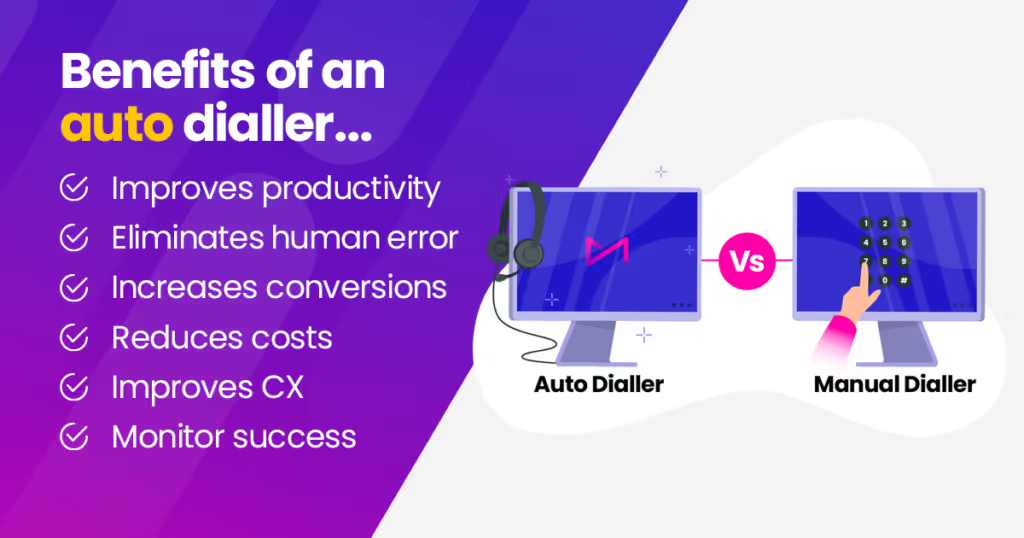
A manual dialler is like a traditional phone. An agent manually dials numbers from a call list, one after another. Whereas an auto dialler, as the name suggests, automates much of the dialling process. It digitally dials numbers, and can also dial multiple numbers at once, passing answered calls to available agents.
Most call centres opt for auto dialling because it significantly boosts productivity, eliminates human error and allows agents to spend more time talking to customers and less time dialling.
Spend 2–3 times longer speaking to people with automated dialling

Where does this productivity leap come from?
Some of the productivity gains from dialler software are built on predictive dialling, in which calls are placed at a rate the dialler expects agents to become free from their previous conversation. Calculating this rate is done by the predictive algorithm.
Predictive dialling is supported by two further modes, progressive and preview dialling. In progressive mode, the dialler waits to make the call until the agent becomes free, rather than estimating that time in advance. Preview dialling allows the agent to review information about the contact before the call is made.
All three dialler modes have a role to play, and getting the right combination means agents typically spend two to three times longer actually talking to clients, and so meeting the overall aims of the business, than if they were managing their own calls manually.
Compliance myths in the contact centre industry
In order to get compliance right, the first step is separating facts from myths. There are two persistent compliance myths in the call centre industry.
Myth 1: Ofcom specifies a target of 3% for dropped calls.
Some software diallers might even be calibrated to produce 3% dropped calls and claim this is compliance.
This is not the case. Ofcom wants to see 0% dropped calls, and a contact centre operator needs to demonstrate they are doing everything they can to achieve that. The 3% figure is a benchmark. It means that so long as an operator is doing all they can to minimise dropped calls, Ofcom accepts that mistakes can and will happen.
Myth 2: A dropped call number cannot be rung again within 72 hours.
Wrong again. What matters is that an agent must be on hand if the call is answered.
Explore our no-nonsense guide to all current Ofcom regulations >
Real world conditions that lead to dropped or silent calls

In a perfect world, a predictive dialler would make outbound calls at a rate that always exactly matched the agents available to connect to clients. But it’s never that simple. Instead, let’s run through some of the ways outbound dialling can get out of sync, and ask what the consequences are.
The most obvious way is that agents are people. They log in and out unexpectedly. They have to go for meals and comfort breaks.
Then there are blended environments. Agents taking inbound calls means that they aren’t available for outbound calls, and so the predictive algorithm gets the rate of outbound calls wrong. Blended environments are like a football match against Brazil. They’re always going to be tough.
In effect, there’s always the risk of an avoidable own goal, which simply means making too many outbound calls when there aren’t enough agents available to cope.
Dropped Calls
All of these real world conditions can lead to dropped calls. And dropped calls aren’t the only compliance challenge. Redialling the same number too soon after a dropped call can be an issue if not handled properly. As is repeatedly dialling a number that has asked not to be called.
Silent Calls
Then there are silent calls. A silent call is when answer machine detection (AMD) registers a false positive, meaning a person answers but the dialler software thinks it’s an answer machine and hangs up.
“For some people – for example, those living alone – these calls can be particularly frightening,” says Ofcom.
The penalty for getting compliance wrong
Ofcom has fined several call centres over the years for various violations, including making nuisance calls, breaching regulations regarding silent and abandoned calls, and failing to provide proper customer service. The fines can vary widely depending on the severity of the violations.
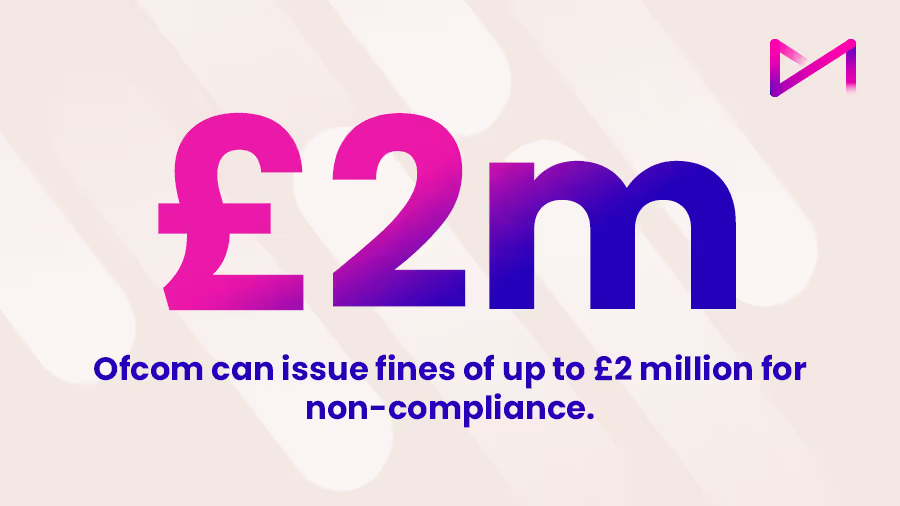
Back in 2013, TalkTalk was fined £750,000 after the company swamped potential customers with silent calls and Barclaycard has received a £50,000 fine. For repeat offenders, it can mean a potential fine of up to £2 million!
The good news is that, according to Ofcom statistics, the average number of nuisance calls – including silent and abandoned calls – reported by consumers who received them, is at its lowest point ever.
- Over the last six years, the number of complaints Ofcom has received related to silent and abandoned has decreased by 65%.
- In 2022, Ofcom received a total of 15,186 complaints related to these calls, compared to 42,822 in 2016.
Data Source: Enforcement programme into silent and abandoned calls
How to balance agent productivity and compliance?
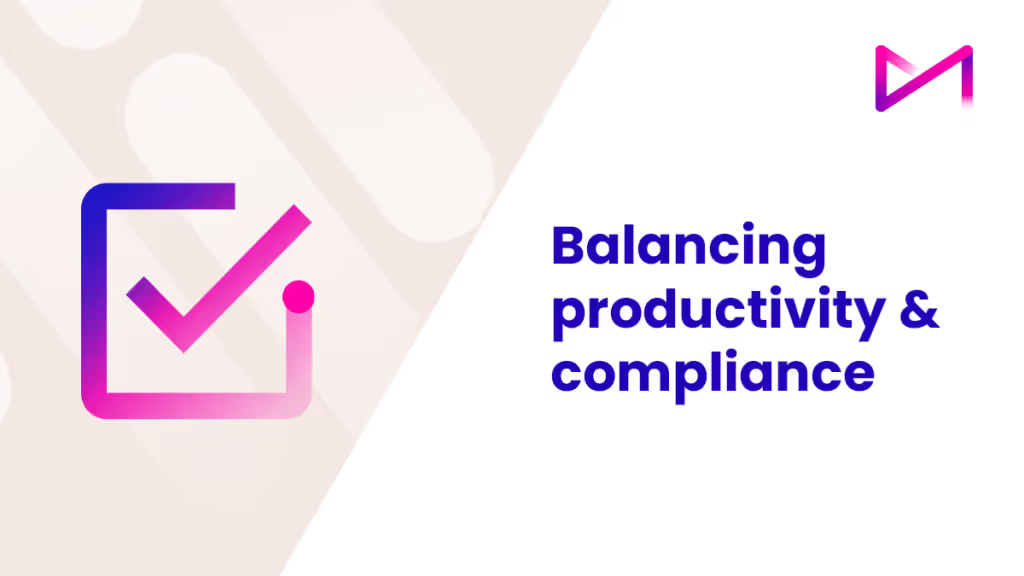
A dialler software solution that can deliver outstanding productivity gains without putting compliance at risk will have a checklist of key features.
- It should head off the causes of dropped calls before they happen. That means agents have to request their next action, such as logging off. Given this information, the predictive dialler can adjust its outbound call rates to match.
- In blended environments, the predictive algorithm has to allow for inbound calls.
- The dialler should move seamlessly from predictive to progressive dialling at times when there are fewer agents, for example during lunch breaks.
- When recalling numbers within 72 hours, the dialler should switch to preview mode so that an agent is guaranteed to be available if the call gets through.
- It should eliminate silent calls due to AMD by passing the call to an agent if there is any doubt, and should leave a message in any circumstances where a call isn’t picked up, completely avoiding any silent calls.
- Finally, the dialler software should automatically integrate and update Do Not Call lists, and allow clients to add themselves to the list.
The most compliant dialler will always be the most productive
Contact centres need to do all they can to avoid falling foul of these rules, and potentially taking significant financial and reputational damage.
MaxContact has 25 years experience performing at the highest level across all forms of contact centres. We understand compliance because we help to define the standards through involvement in Ofcom consultations around persistent misuse of software diallers.
Book a customised demo today to learn about our dialler software and ask us any questions about compliance in your contact centre.
.png)
The Future of Digital Customer Engagement: MaxContact's Contact Hub Boosts Agent Productivity Using Digital Channels
To keep pace with evolving customer expectations, businesses are constantly seeking ways to enhance their customer experience whilst improving operational efficiency. At MaxContact, we’re proud to introduce Contact Hub Connect, our next generation agent interface that not only meets your customers where they are but also significantly boosts agent productivity.
The Shifting Landscape of Customer Engagement
The way customers interact with businesses has undergone a dramatic transformation in recent years. As Kayleigh Tait, Head of Marketing at MaxContact, points out, “We’re looking at research around usage of digital channels. The average consumer uses 6 touchpoints across various different channels when making a purchase, and that’s in comparison to 2 touchpoints from 15 years ago.”
This shift underlines the increasing importance of digital channels in customer interactions. Customers now expect seamless communication across multiple platforms, including email, web chat, SMS, and voice. Contact Hub Connect has been designed with this multi-channel reality in mind, providing a unified interface that allows agents to effortlessly navigate between different communication channels.
MaxContact’s Commitment to User-Driven Development
At the heart of Contact Hub Connect is our commitment to user-driven development. Elin Simmonds, our UX lead, emphasises the importance of involving users throughout the design journey: “It’s very important that the people are actually building the product understand how the end users use it.”
This user-centric approach involved extensive research, including interviews and site visits with both agents and managers. By observing how agents interact with existing systems and identifying pain points, we’ve created a solution that addresses the needs of those on the front lines of sales, collections and customer service.
5 Ways Contact Hub Connect Boosts Agent Productivity
Let’s dive into the specific features that make Contact Hub Connect a game-changer for agent productivity:
1. Unified Inbox for All Digital Channels:
Contact Hub Connect introduces a streamlined inbox that consolidates all digital interactions – email, web chat, and SMS – into a single, easy-to-navigate interface. This unified approach allows agents to seamlessly switch between different channels without the need to toggle between multiple systems or windows.
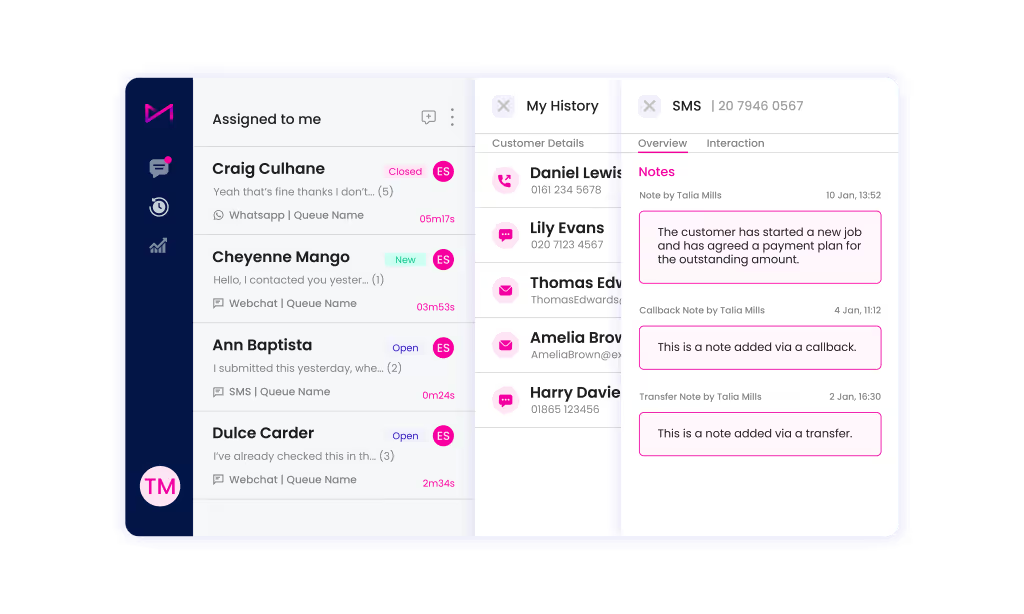
2. Improved Customer History and Context:
With Contact Hub Connect, agents have instant access to comprehensive customer information and interaction history. As Elin explains, “We can see what the digital history of a customer looks like, as well as voice history.” This feature provides agents with valuable context, enabling them to provide more personalised and informed service.
3. Enhanced Canned Responses and Shortcuts
We’ve reimagined how agents can use pre-written responses and shortcuts. The new system allows for quick insertion of canned responses using keyboard shortcuts, with a preview feature that lets agents see and edit the full response before sending.
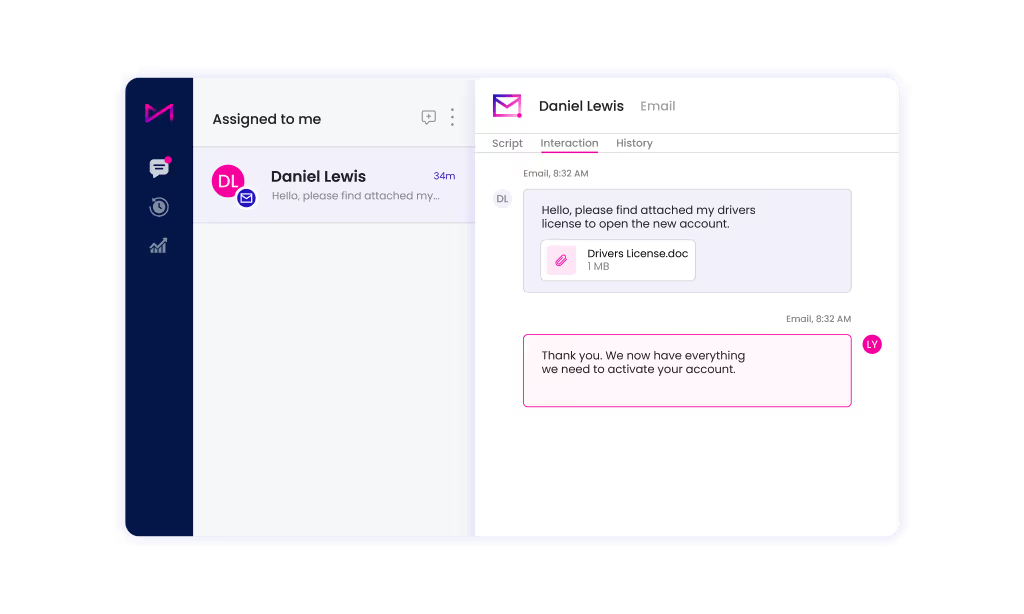
4. Integration with Spokn AI for Voice Transcripts and Insights
For users with Spokn AI enabled, Contact Hub Connect provides powerful insights derived from voice interactions. Agents can access call summaries, sentiment analysis, and key topics discussed, all within the same interface. This integration helps bridge the gap between digital and voice interactions, providing an omnichannel view of customer communications.
5. Seamless Switching Between Digital and Voice Interactions
Contact Hub Connect isn’t just about digital channels – it’s designed to work seamlessly with voice interactions as well. Agents can easily initiate a voice call from within a digital interaction, with all the familiar call controls and scripting tools available at their fingertips. This integration ensures that agents can provide consistent service regardless of the channel.
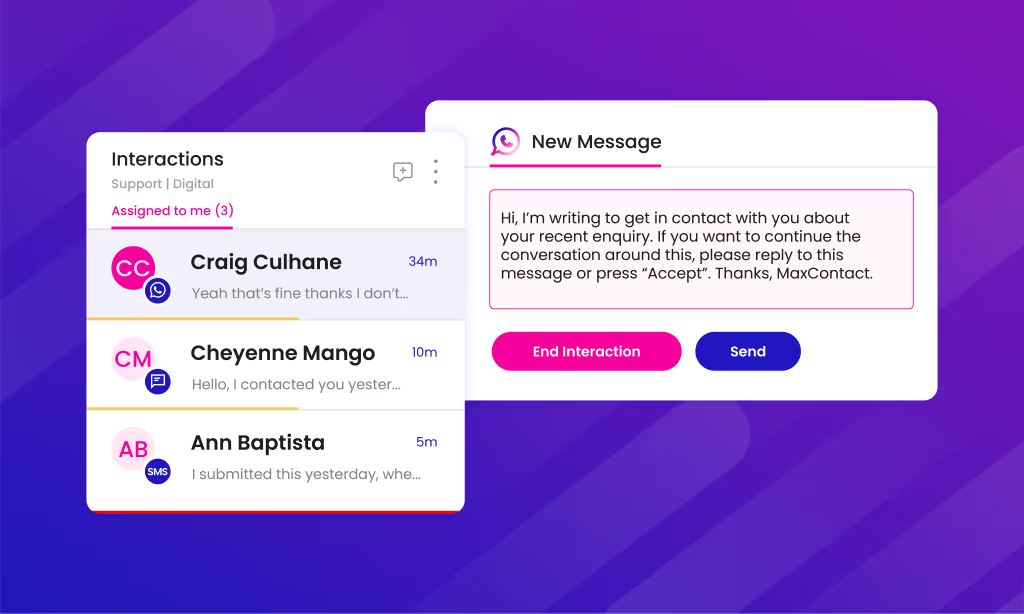
Looking to the Future
Contact Hub Connect represents a significant step forward in our vision for the future of sales, collections and customer service. By providing agents with the tools they need to work efficiently across all channels, we’re enabling businesses to meet the evolving expectations of their customers and their growth targets.
As we continue to refine and expand Contact Hub Connect, we’re excited about the possibilities for future enhancements. We’re exploring ways to further leverage AI and automation to support agents, as well as looking at additional integrations that will make the platform even more powerful and versatile.
Are you ready to upgrade your customer interactions and boost your agent productivity? Contact us today to learn more about Contact Hub.
.png)
The Difference Between Multichannel and Omnichannel contact and why it matters to your customers
For many contact centres, customer expectations have shifted when it comes to communication. Customer Service has become Customer Experience – and it’s a real differentiator for businesses.
An ever-increasing proportion of consumers look for digital touchpoints when it comes to communication, and they want choice in the way they interact with organisations. Although voice still accounts for most customer interactions, contact centres are increasingly expected to provide non-voice channels such as Webchat, email and SMS to meet customer demand.
What is the difference between a “Multichannel” and “Omnichannel” contact centre?
If you’re looking to expand the capabilities of your call centre with non-voice channels, you must understand the difference between a multichannel solution and an omnichannel solution so you choose the right technology for your business operations.
What is a multichannel contact centre?
A multichannel contact centre provides basic flexibility by offering more than one method of communication such as phone, text and email. A multichannel solution gives customers a choice of channels, they often operate independently. A customer’s interaction history on one channel isn’t visible on others, which leads to fragmented customer service and frustration.
What is an omnichannel contact centre?
An omnichannel contact centre solution also offers a choice of channels, but with the crucial difference that converged communications are all in one place. Think of a customer service team where agents have a complete view of a customer’s interactions across all channels. If a customer starts a conversation via chat and then calls, the agent can pick up right where they left off.
While multichannel contact centres offer a basic level of flexibility, they often fall short in providing a truly seamless and personalised customer experience. The limitations of multichannel can lead to frustration for both customers and agents.
Omnichannel contact centres may require a higher initial investment, but the benefits far outweigh the costs. By providing a seamless, personalised customer experience, omnichannel can significantly improve customer satisfaction, increase efficiency and give businesses a competitive edge.
5 considerations when choosing an omnichannel engagement software
With that in mind, here are five things you must look out for when considering a new omnichannel contact centre solution.
Security and Integration
It goes without saying that your next omnichannel engagement software needs to be super secure, but what does that mean in practice?
- Ensure the software complies with data privacy regulations like GDPR and CCPA.
- Look for certifications like ISO 27001 and Cyber Essentials to verify the software’s security.
- Assess the software’s ability to integrate with your existing systems, such as CRM and payment gateways.
Flexibility and Scalability
Businesses change – so choose an omnichannel solution that can adapt to your needs and scale as your business grows.
- Can the software be customised to meet your specific business needs and workflows?
- Can the software handle increased call volumes and support future growth?
- Does the software offer the necessary features, such as routing, IVR, and reporting, to meet your requirements?
Insights and Reporting
Effective reporting is crucial for understanding customer behaviour and optimising your operations – so what should you look out for when considering omnichannel software?
- Can the software provide real-time data on key metrics like call volume, average handling time and customer satisfaction?
- Can you create custom dashboards to visualise the data that matters most to your business?
- Does the software leverage AI to analyse call recordings and identify trends?
Ease of Use
Omnichannel solutions with a user-friendly interface can improve agent efficiency and reduce training costs.
- Is the software intuitive and easy to navigate for both agents and supervisors?
- Does the provider offer comprehensive training and support resources?
- Does the software provide tools like knowledge bases, scripting and screen sharing to enhance agent productivity?
Compliance
Effective omnichannel software should help you meet regulatory requirements and provide tools for compliance.
- Does the software help you meet industry-specific regulations, such as those related to telemarketing or debt collection?
- Are there features like call recording, scripting, and “Do Not Call” list integration to ensure compliance?
Additional Considerations
- Hidden Costs – Be aware of potential hidden costs, such as fees for additional features or demos.
- Support – Evaluate the quality and responsiveness of the provider’s support services.
- Expertise – Choose a provider with deep expertise in contact centre solutions.
- Accreditations – Verify the provider’s compliance with industry standards and regulations.
Why Choose MaxContact?
MaxContact is a powerful omnichannel contact centre solution offering a full range of contact options, from voice and email to SMS, webchat and even WhatsApp.
This is a fully converged service that puts all customer interactions in one place for seamless communication. For more information on our omnichannel solution, book a demo, or download our omnichannel brochure.
.png)
The Crucial Role of Instant and Accurate Customer Service
Customer service teams are the unsung heroes of businesses; they have the power to transform ordinary transactions into extraordinary customer experiences. The importance of customer service teams can often be overlooked by businesses but is seen as a necessity by customers who demand instant and correct answers to their questions. How do businesses support their customer service teams in the age of instant gratification?
Instant Gratification in the Digital Age
The Amazon effect has created a culture of instant gratification. Consumers expect quick responses and resolutions to their queries, and businesses that meet these expectations gain a competitive edge. A study by HubSpot revealed that 90% of customers rate an “immediate” response as essential when they have a customer service question. Instant responses have become the norm, with customers seeking solutions in real-time.
Building Trust Through Speedy Responses
In customer service, trust is the currency that fosters loyalty. When a customer receives an immediate response, it sends a powerful message — the business values their time and concerns. This trust forms the foundation of a long-lasting customer relationship. Salesforce reports that 75% of customers expect companies to provide a consistent experience wherever they engage, whether through social media, in-person, or online. Consistency, coupled with speed, builds a sense of reliability that customers appreciate.
Correct Answers: A Non-Negotiable for Customer Satisfaction
While speed is vital, correctness is crucial. Providing accurate and reliable information ensures that customers get their answers promptly and receive solutions that genuinely address their needs. A correct answer the first time around eliminates frustration, reduces the need for follow-up inquiries, and enhances overall customer satisfaction. However, with increasingly complicated tech stacks and processes in place, the ability for customer service teams to get access to the right answer quickly can be troublesome.
Preventing Escalations and Retaining Customers
Instant and correct answers play a pivotal role in preventing issues from escalating. By resolving problems swiftly and accurately, businesses can nip potential conflicts in the bud. According to a survey by Qualtrics and ServiceNow, 80% of customers said they have switched brands because of poor customer experience. By delivering what customers need when they need it, businesses can reduce the likelihood of customer churn and foster a positive reputation.
Technology as an Enabler
The rise of advanced technologies has empowered customer service teams to meet the demands of instant and correct responses. Artificial Intelligence (AI) and chatbots, for instance, can provide instant answers to common queries, freeing human agents to handle more complex issues. However, it’s crucial to strike a balance — while technology can enhance efficiency, the human touch remains irreplaceable in certain situations, especially when dealing with nuanced queries or emotional concerns.
A Customer-Centric Approach for Business Success
In the ever-evolving business landscape, customer service teams are brand ambassadors, directly influencing a company’s reputation and success. Combining instant and correct answers is a potent formula for building trust, retaining customers, and ultimately driving business growth. As businesses continue to navigate the age of AI, prioritising the speed and accuracy of customer service responses will undoubtedly be key to their success.